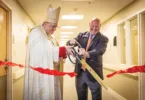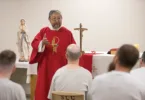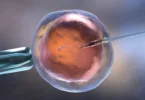by Jill Ragar Esfeld
LAWRENCE — For several years, Andy Marso, a parishioner at St. John the Evangelist here, dreamed he was back in the tank room.
Once again, he would be lying, crucifixion-style, on a metal table, blood dripping from his hands and feet as doctors scraped away flesh in an effort to find viable tissue.
Once again, the pain would be so excruciating it took not only his breath — but his prayers — away. He couldn’t even think to repeat a simple Hail Mary.
So his pain became his prayer, an offering in union with Christ.
When he had the nightmares, it all seemed so real again.
Then Andy began writing about his experience — putting to paper his horrific struggle to overcome a deadly disease.
It wasn’t easy.
“There were days when I was sitting at my computer just weeping,” he said.
But he kept writing. And slowly the nightmares went away.
“It was extremely cathartic,” he said of the experience. “And if it had never been published, it still would have been well worth doing for that reason.”
In November, Marso’s book was published under the title “Worth the Pain: How Meningitis Nearly Killed Me — Then Changed My Life for the Better.”
It’s a page-turner that has received rave reviews. But that really doesn’t matter to Marso.
What matters to him is that others benefit from his experience.
Life turned upside down
Marso’s journey began nine years ago when he was a senior at the University of Kansas in Lawrence.
Just a few finals away from his journalism degree, he had a job in his pocket and a bright future ahead.
Then he came down with what he thought was the flu. He also noticed a strange purplish rash.
“I went to bed thinking I had the flu,” he recalled. “And by the next morning, I couldn’t get out of bed. And that night, I was in intensive care.”
Marso’s parents, who live in Minnesota, headed straight for Kansas City when they got the news.
His mother Virginia vividly remembers arriving at the hospital, and the moment at which the gravity of the situation hit her and her husband.
“After we’d been allowed to spend a couple of minutes with him,” she said, “the doctor took us aside and told us that it was a very real possibility that he might die before the next morning.”
Marso survived the night and eventually was put into a drug-induced coma. But each day was a question mark, as he continued to battle the disease.
When he woke three weeks later, he had beaten the odds — but at a cost.
Because the bacterial infection caused a loss of circulation, his extremities had turned black — the tissue damage was equal to third-degree burns.
“I was given a choice,” said Marso. “Either amputate my limbs or go through burn-unit treatments.”
Marso spent the next four months in and out of the tank room, where burn treatments are administered. He was given Fentanyl for the pain but, as his body acclimated to the drug, it did little to ease his suffering.
“It gets to the point where it wears off pretty quickly,” he explained. “At first, I was conscious, but basically out of it.
“A couple of weeks into it, I would start to kind of feel things after a half- hour.”
Because of its potency, Fentanyl can be administered only once an hour.
“A month into it, I would start to feel things after 15 minutes,” he said. “It became very difficult.”
Suffering with Christ
Then Marso experienced a turning point in his attitude toward the treatments. He’s not sure if it was a vision or if it actually happened, but he remembers a Hispanic woman coming into his room and standing at the foot of his bed.
“I know you will be OK, because you have the wounds of Christ,” she said.
“She was pointing to my hands and feet which were all bandaged,” Marso recalled.
At that moment, he began to realize he was united with Christ in his pain, and had been given a unique perspective of the Passion.
“This was the kind of pain that Jesus chose,” he said. “This is the kind of thing that he said, “Yeah, I’ll take that on if that’s what I have to do.’
“At the time, that is not a choice I could imagine making.”
His mother experienced a similar empathy with the Virgin Mary.
“My husband and I had to go into the tank room on two occasions,” she said, “so we could really understand what was going on and why he had to have these amputations.
“And I kind of felt myself in the shoes of Mary at that point, because he’s there on this stainless-steel table in a crucifixion pose.
“And what’s really hard is you have to be so stoic — you can’t let him know how horrified you are, because that’s just going to make him feel worse.”
Through the course of his four months of treatment, all of Marso’s fingers and toes were amputated.
“I still have my right thumb,” he said. “It’s damaged at the joint, but it’s still there. And I have a little stub of my left thumb left.”
And in the months after that, Marso had to relearn basic skills he hadn’t even thought much about — much less struggled with — since he was a small child.
“I had to learn everything from the time I got up in the morning,” he said. “I had to learn how to dress myself, use the bathroom and shower.”
A Catholic cocoon
The family had rented an apartment while Marso underwent the long and arduous challenge of rehab and attended St. Pius X Church in Mission during their stay. The family was grateful for the support and compassion they found there.
“We loved St. Pius,” said Virginia Marso. “We’re very active in our church up here [in Minnesota] and St. Pius became a haven for us.”
By the time Marso was released from the hospital and could attend Mass with his parents, the entire parish knew who he was.
Understandably, he was self-conscious about being in public again. He remembers his reception at St. Pius as comforting.
“I had all of these scars and skin grafts and amputations that I was trying to deal with,” he said. “It helped to have that cocoon of people who understood what I’d gone through and weren’t going to ask me any uncomfortable questions.
“They were just supportive.”
As friends and family supported Marso, his determination to recover was an inspiration to everyone around him.
“Andy’s always had a very positive attitude,” said his mother. “When he got out of his medically induced comma, it was pretty much ‘OK, what’s the plan? What do I need to do?’”
Marso worked his way back to complete self-sufficiency, learning to walk — something doctors said he might never be able to do — and learning to type quickly enough to write full time as the state government reporter for the Topeka Capital Journal newspaper, where he works today.
“There are so many times when my husband and I marvel at him,” said his mother. “We don’t know how he does these things.”
And, of course, he’s written a book — a book he hopes will bring about a greater awareness of the risks of bacterial meningitis and also recognize the many people who helped him fight, heal, and restart his life.
But most of all, Marso hopes his book will champion the love and compassion that poured into his family from friends and strangers alike — and the love that gave meaning to his experience by helping him understand the purpose of suffering.
“If nobody suffers,” he explained, “nobody has a chance to show deep love and compassion.
“Someone has to suffer in order for that to happen.
“Somebody’s got to take one for the team, as they say.”






